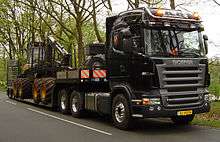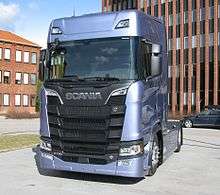Scania PRT-range
| Scania PRT-range | |
|---|---|
 Scania G 420, P 380, R 420 and more. | |
| Overview | |
| Manufacturer | Scania |
| Production | 2004–present |
| Assembly |
|
| Body and chassis | |
| Class | Commercial vehicle |
| Body style |
|
| Powertrain | |
| Engine | |
| Power output | 230-730 hp |
| Transmission | Scania Opticruise |
| Chronology | |
| Predecessor | Scania 4-series |


_(2).jpg)
.jpg)


The Scania PRT-range,[2] also referred to as new truck range or Scania's truck range, is the current range of trucks manufactured by the Swedish commercial vehicle manufacturer Scania. It was first introduced as the successor to the 4-series in spring 2004 with the high forward control cab Scania R-series, followed by the low forward control cab Scania P-series and bonneted cab Scania T-series later in the year. The T-series was discontinued in 2005, and in 2007 the medium forward control cab Scania G-series was introduced. The entire range is modular, giving a wide range of different configurations for different types of trucks. The trucks are available with engines ranging from a 9-litre I5 to a 16-litre V8, with the V8 only being available in the R-series (and formerly T-series). A successor to the range was launched in August 2016 with new R-series and flat-floor S-series sleeper cabs.
First generation (2004–2016)
The range was first launced with the R-series on 31 March 2004, replacing the R94, R114, R124 and R164 of the 4-series. It had 65 percent of the same components as its predecessors, but with a new cab design, new interior and other technical improvements. Full scale production started in Södertälje (Sweden) in April, Zwolle (the Netherlands) in May and in Angers (France) in June. At launch it was available with Euro III engines, but with a 420 hp Euro IV engine available from September.[3] On 20 August, the P- and T-series were launched too, completing the new truck range and replacing the rest of the 4-series models. The new models made their public debut at the IAA commercial vehicle show in Hanover in late September.[4] Production of the 4-series was continued at the Scania Latin America plant in São Bernardo do Campo (Brazil), but was from October 2004 relaunched as the Série Evolução (Evolution Series), featuring the new engines of the PRT-range and the same new model designation, but with the old 4-series cabs.[5][6]
In October 2005, Scania decided to discontinue the bonneted T-series, having lost its market share over the years. Over the last decade the sales had been halved in Europe and gone down 90 percent in Latin America. In 2004, fewer than 1,000 bonneted Scania trucks were sold worldwide, meaning there was no longer a market for it.[7] In late 2006, Scania launched a new low-entry version of the P-series cab, known as the CP19E, specially intended for garbage trucks, where the driver needs to get in and out quickly.[8] This cab was targeted as a competitor to the Mercedes-Benz Econic.
On 5 September 2007, Scania launched the all-new G-series, with a cab height between the P-series and the R-series. It should not be confused with the old G cab of the 2- and 3-series, which was even lower than the P cab, nor with the G chassis of the 4-series (ie. 94G).[9] On 9 October 2007, the new range was also launched in Latin America, featuring all three P-, G- and R-series from the start.[10] In April 2008, Scania unveiled their first ethanol-powered (ED95) trucks, having manufactured ethanol-powered buses for nearly two decades.[11]
On 17 September 2009, an upgraded R-series was launched with many new features including a sharper exterior styling with larger grille openings,[12] new interior details including the possibility of a factory-installed coffeemaker,[13] new version of the Scania Opticruise gear system with automatic clutch[14] and a driver support system.[15] The G-series received the upgrade shortly afterwards, and the P-series during 2011.
In April 2010, Scania launched a new version of its V8 engine, allowing a maximum output of 730 hp and 3500 N·m in trucks, and preparing for the future Euro VI emission requirements.[16] The new R 730 then became the most powerful large-scale production truck in the world, only to be surpassed by the Volvo FH16 750 (750 hp, 3550 N·m) in September 2011.
Second generation (2016–present)
Since Scania signed a deal with Porsche Engineering in August 2010, a completely new truck cab has been in development.[17] From early 2014, several masked prototypes have been spotted on roads in Sweden,[18][19] Spain[20] and Norway.[21][22] The next generation of trucks from Scania was launched at the Grand Palais in Paris on 23 August 2016.[23] The launch included new R-series sleeper cab[24] and the all-new S-series sleeper cab[25] which offers a flat interior floor. Other cab heights, including R-series day cab, of the new generation will have a later launch. The first display of the new generation to a public audience occurred at the Elmia Lastbil fair in Jönköping, Sweden one day later, on 24 August.[26]
Model designation
Scania use different model designations for different contexts. A simplified truck model designation is used for marketing and is visible in the grille. Another complete designation defines the characteristics of the chassis and the drivetrain, and a third designation defines the cab configuration.[27]
Truck model
The simplified truck model name consists of the cab type and power code, divided by a space. Examples: R 730, G 440, P 270.
Complete vehicle
- Cab type
- P: Low forward control cab
- G: Medium forward control cab
- R: High forward control cab
- T: Bonneted cab
- S: Highest forward control cab with flat floor
- Power code
Approximation of the power rating in hp to the nearest ten. The power code has spaces on both sides.
- Type of transport
- L: Long-distance haulage
- D: Distribution
- C: Construction
- Chassis adaption
- A: Tractor unit (Articulated)
- B: Truck bodywork (Basic)
- Wheel configuration
- 4x2: two-axle
- 4x4: two-axle, all-wheel drive
- 6x2: tri-axle, rigid tag axle
- 6x2/2: tri-axle, rigid pusher axle
- 6x2/4: tri-axle, steered pusher axle
- 6x2*4: tri-axle, steered tag axle
- 6x4: tri-axle, double drive axle
- 6x6: tri-axle, all-wheel drive
- 8x2: four-axle, double front axle, rigid tag axle
- 8x2/4: four-axle, steered pusher axle, rigid tag axle
- 8x2*6: four-axle, double front axle, steered tag axle
- 8x4: four-axle, double front axle, double drive axle
- 8x4*4: four-axle, double drive axle, steered tag axle
- 8x8: four-axle, all-wheel drive
- Duty class
- M: Medium duty, for transport on even surfaces
- H: Heavy duty, for transport on uneven surfaces
- E: Extra heavy duty, for off-road transport
- Chassis height
- E: Extra low
- L: Low
- N: Normal
- S: Semi high
- H: High
- Suspension
- A: leaf-spring suspension front and air suspension rear
- B: air suspension front and rear
- Z: leaf-spring suspension front and rear
Examples:
- P 230 DB4x2MNA: Low forward control cab, 230 hp, distribution truck
- R 730 CA8x8EHZ: High forward control cab, 730 hp, four-axle all-wheel drive, off-road tractor unit
Cab
- Cab type
The cab type consists of C and the corresponding letter for the main cab type; CP, CG, CR and CT.
- Cab length
Interior distance between front and rear walls, measured in decimetres.
- 14: Short cab
- 16: Day cab
- 19: Sleeper cab
- 28: CrewCab (5−6 persons)
- 31: Long CrewCab (6−8 persons)
- 32: Extended sleeper cab
- Roof height
- N: Normal
- L: Low
- E: Low boarding step, normal roof height (Low entry)
- H: High (Scania Highline)
- T: Full height (Scania Topline)
Examples:
- CP19E: Low entry cab, for garbage trucks
- CP31: Long crew cab, for fire engines
References
- ↑ "Spacious all-wheel-drive heavy-haulage tractor – tailored solutions are standard from Scania" (PDF). Scania AB. 8 September 2011.
- ↑ "2004: Launch of the R-series". Scania AB. Retrieved 1 April 2016.
- ↑ "Scania launches new truck range: Operating economy, driver appeal, Euro 4 engines". Scania AB. 31 March 2004. Archived from the original on 15 April 2004.
- ↑ "Scania’s new truck range complete" (PDF). Scania AB. 20 August 2004.
- ↑ "Caminhões Scania têm nova identificação" [Scana trucks have new identification] (in Portuguese). Scania Latin America. 27 October 2004. Archived from the original on 7 April 2005.
- ↑ "Caminhões Scania − Rodoviário" [Scana Trucks − On Road] (PDF) (in Portuguese). Scania Latin America. October 2004. Archived from the original (PDF) on 25 February 2005.
- ↑ "Scania’s T-model says goodbye (extended version)". Scania AB. 21 April 2005. Retrieved 2 April 2016.
- ↑ "Scania launches refuse collection trucks with innovative low-entry cab" (PDF). Scania AB. 7 December 2006.
- ↑ "Extended truck range: 50% broader choice with P-, G- and R-series" (PDF). Scania AB. 5 September 2007.
- ↑ "Renovação completa da linha de caminhões Scania: Séries P, G e R com novas cabines e motores" [Complete renovation of Scania truck range: P-, G- and R-series with new cabins and engines] (in Portuguese). Scania Latin America. 9 October 2007. Archived from the original on 22 October 2007.
- ↑ "World premiere for Scania’s first ethanol-powered trucks − rapid transition to sustainable urban transport" (PDF). Scania AB. 15 April 2008.
- ↑ "New Scania R-series: Sharper look with improved fuel economy". Scania AB. 17 September 2009. Retrieved 2 April 2016.
- ↑ "New Scania R-series: Improved truck driver station – and sleeping comfort". Scania AB. 17 September 2009. Retrieved 2 April 2016.
- ↑ "New Scania R-series: Faster gearchanges and precision clutch control". Scania AB. 17 September 2009. Retrieved 2 April 2016.
- ↑ "New Scania R-series: Real time advice saves fuel". Scania AB. 17 September 2009. Retrieved 2 April 2016.
- ↑ "Scania completes its changeover to Euro 6 technology with the world’s most powerful truck" (PDF). Scania AB. 16 April 2010.
- ↑ "Scania signs development agreement with Porsche" (PDF). Scania AB. 30 August 2010.
- ↑ "Her er nye Scania" [Here is the new Scania]. Transportmagasinet (in Norwegian). Fagmedia AS. 12 February 2014. Retrieved 2 April 2016.
- ↑ "Ny anleggs-Scania på vei" [New construction Scania on its way]. Transportmagasinet (in Norwegian). Fagmedia AS. 4 March 2015. Retrieved 2 April 2016.
- ↑ "Scania avslørt i Spania" [Scania revealed in Spain]. Transportmagasinet (in Norwegian). Fagmedia AS. 3 September 2014. Retrieved 2 April 2016.
- ↑ "Her er den i Norge" [Here it is in Norway]. at.no (in Norwegian). Bjørgu AS. 24 April 2015. Retrieved 2 April 2016.
- ↑ "Spionbilder av Scania på norske skilter" [Spy photos of Scania on Norwegian plates]. Transportmagasinet (in Norwegian). Fagmedia AS. 12 January 2016. Retrieved 2 April 2016.
- ↑ "Grandiose birth of a new Scania". Scania AB. 23 August 2016. Retrieved 26 August 2016.
- ↑ "New R-series". Scania AB. Retrieved 26 August 2016.
- ↑ "S-series". Scania AB. Retrieved 26 August 2016.
- ↑ "Solen sken över Scanias historiska premiär" [Sun was shining over Scania's historical premiere] (in Swedish). Elmia. 24 August 2016. Retrieved 26 August 2016.
- ↑ "Chassis information and model designations". Scania AB. 2011.
External links
| Wikimedia Commons has media related to Scania PRT-range. |
- Trucks Scania AB